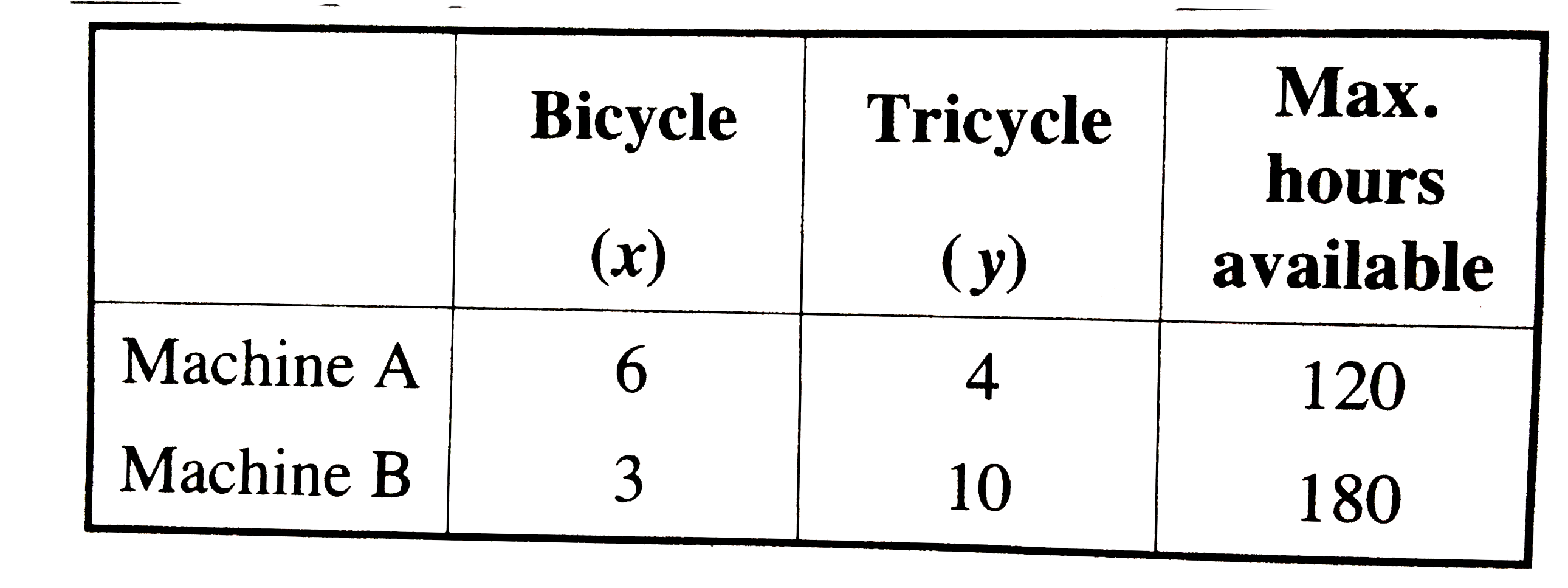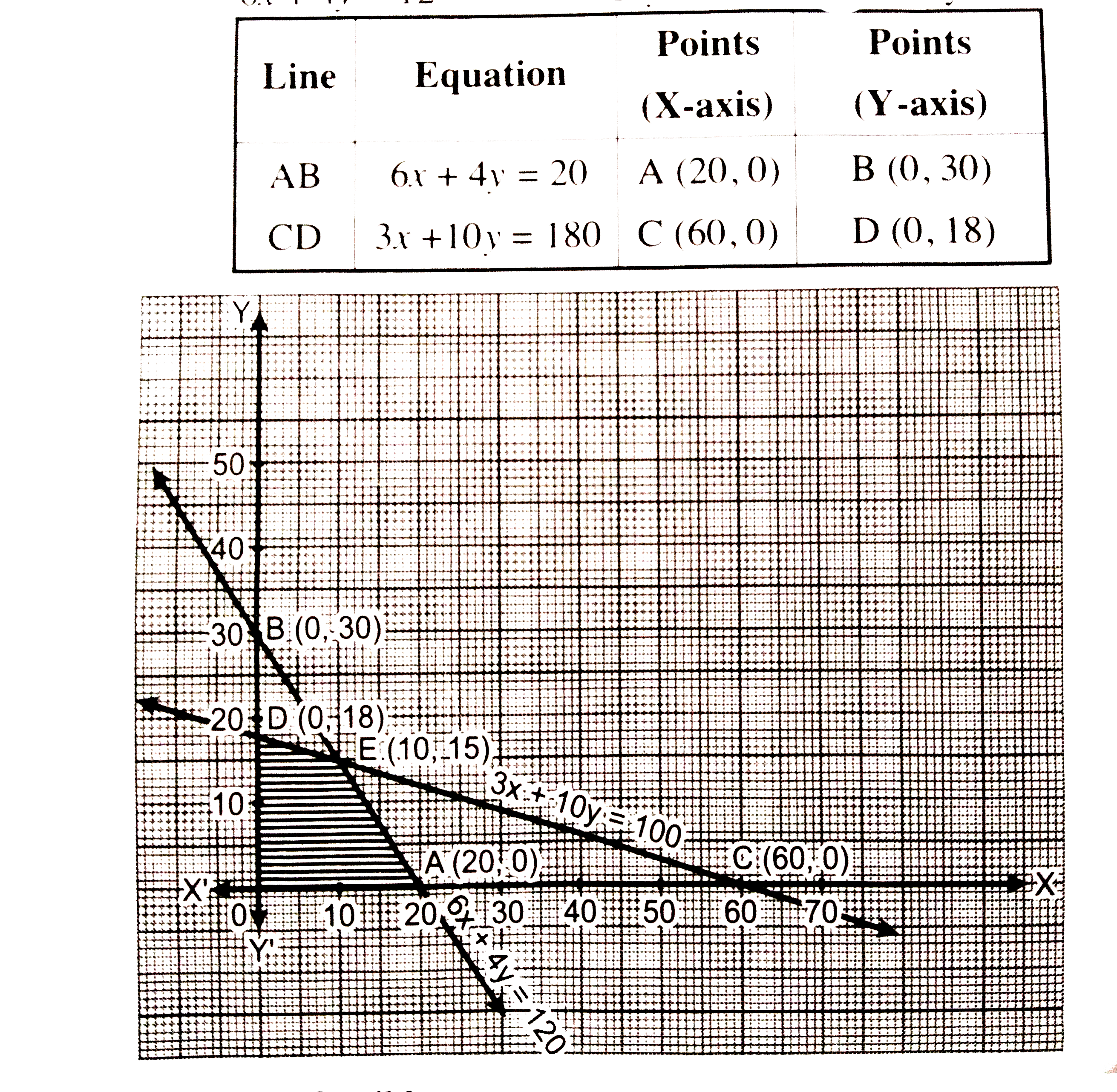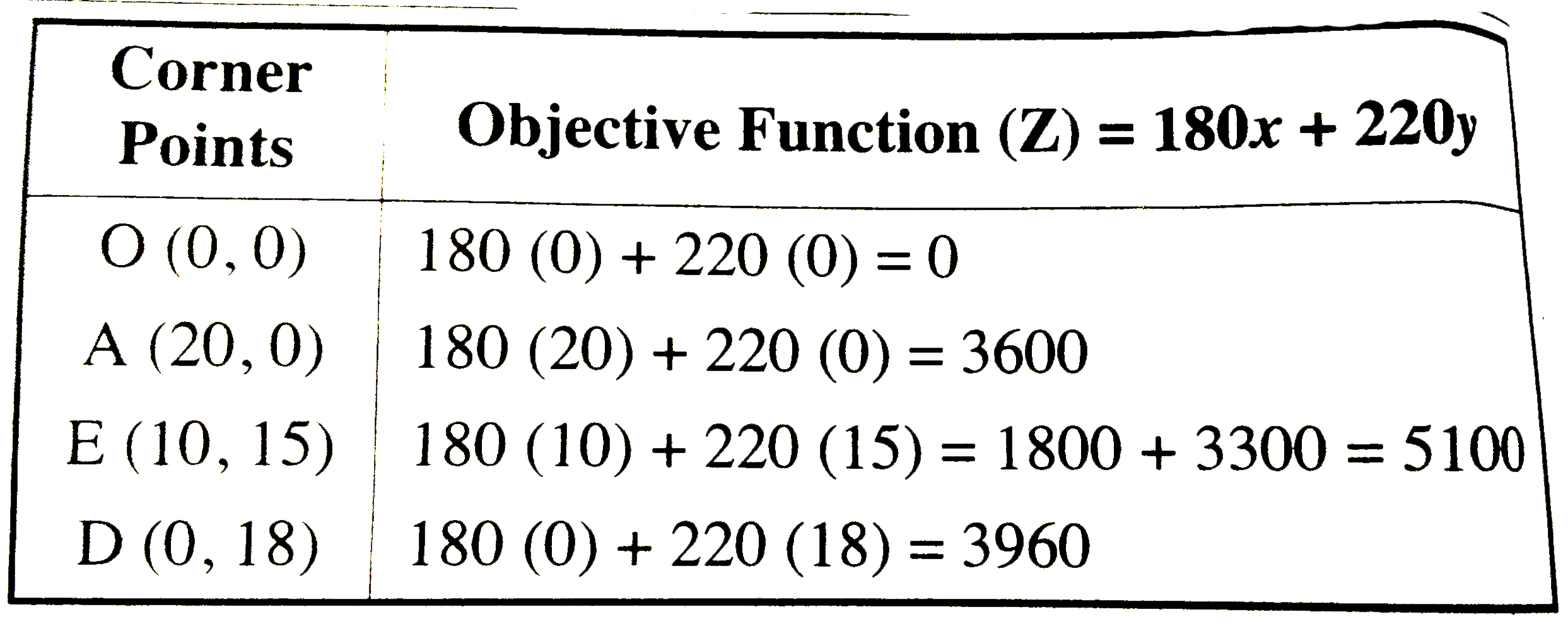InterviewSolution
This section includes InterviewSolutions, each offering curated multiple-choice questions to sharpen your knowledge and support exam preparation. Choose a topic below to get started.
| 1801. |
The seriesof naturalnumbers is divided into groups(1),(2,3,4) : (5,6,7,8,9) and soon . Show the sum of the numbersin the nth groupis (n-1)^(3) +n^(3) |
|
Answer» |
|
| 1802. |
The value ofSigma_(n=1)^(infty) cot^(-1) ( n^(2) + n +1) is also equal to |
|
Answer» `cot^(-1)(-1)+sec^(-1)(1)- COSEC^(-1)(1)` |
|
| 1803. |
Evaluate the following integrals int (2-3 sinx)/cos^2x dx |
| Answer» SOLUTION :`INT ((2-3SINX)/cos^2x)DX = int(2/cos^2x -(3sinx)/cos^2x)dx = int(2 sec^2x- 3secxtanx)dx =2tanx-3secx+c` | |
| 1805. |
A companymanufactureis bicyles and tricycleseach of whichmust beprocessed through machines A and B. Machine A hasmaximum of 120 hoursavaiableand machine B hasmaximumof 180 hours available hourson machine A and 3 hourson machine B. Machine A and 10 hourson machine B.Ifprofitare ₹ 180 for a bicyleand ₹ 220 for a tricyle , formulateand solvethe L.P.P to determinethenumberof bicyclesand tricycle that should bemanufactured in orderto maximize the profit . |
Answer» Solution :Let x no. of bicyclesand y no.oftricycleare to be manufactured . Then, total profit Z = (180 x+ 220 y) WHICHIS to bemaximized. From table, we have `6X + 4y le 120 , 3x + 10y le 180` ` x ge 0 ,y ge 0` (`because` no . ofbicycles and tricyles cannot be negative) Themathematicalformulation of given LPP is Maximie Z = 180 x + 220y such that`6x + 4yle 120,` `3x + 10y le 180` `x ge 0 , y ge 0` Now , darw the LINE AB and CD of equations `6x4y = 120` and `3x + 10y = 180` respectively  Thefeasibleregion is OAEDO with`O(0,0), A(20,0) E and D (0,18)` E is thepointof intersectionof thelines. `""3x + 10y = 180,"".......(1)` `and""6x + 4y = 120 "".....(2)` Multiplying EQUATION (1) by 2 andsubtracting equation (2) form it , we get `{:(6x + 20y = 360),(6x + 4y = 120),(-" "-" "-),(overline(""16y = 240)):}` `rArr "y = 15` Puttingy= 15 in equation (1), we get x = 10 `therefore E(10, 15)`  HENCE, the maximum valueof Z is5100 at E (10, 15) i.e.,10 bicyles and15 tricylesshouldbe manufactured to maximize the profit. |
|
| 1806. |
10% items are defective manufactured by one company. Find the probability of an event that out of 8 items 2 items are defective. |
|
Answer» |
|
| 1807. |
A shopkeeper sells not more than 15 bush shirts of two colours. At least twice as many white ones are sold as green ones. If the profit on each of the white be Rs. 5 and that of green be Rs. 7.50. The numbers of green shirts to be sold to get maximum profit is |
|
Answer» 5 |
|
| 1808. |
A round table of radius 10 m has four vertical legs fixed at the circumference of the table top in the form of four corners of a square. If the mass of the table is 10 kg, what maximum mass (in kg) can be kept on the circumference of the table so that table doesn't topple is (x/(sqrt(2)-y)), then the value of (x+y) is ? |
|
Answer» |
|
| 1809. |
h(x) is increasing for x in |
|
Answer» `(-(pi)/(4),(pi)/(4))` CASE I `{:("(i) "sin 2x gt0 rArr x in (0,(pi)/(2))),("(ii) "f'(sin^(2)x)gtf'(cos^(2)x) rArr tan^(2)x GT1):}}rArr x in ((pi)/(4),(pi)/(2))` Case II `{:(" (i)" sin2xlt0 rArr x in (-(pi)/(2)","0)),(" (ii)"f'(sin^(2)x)gtf'(cos^(2)x) rArr tan^(2)xgt1):}}rArr x in ((-pi)/(2),-(pi)/(4))` |
|
| 1811. |
The value of the sum .^(1000)C_(50) + .^(999)C_(49) +.^(998)C_(48)+"….".^(950)C_(0) is |
|
Answer» `.^(1001)C_(50)` `=` coefficient of `x^(950)` in `[(1+x)^(950) + (1+x)^(951) + "....."+(1+x)^(1000)]` `=` coefficientof `x^(950)` in `((1+x)^(950)((1+x)^(51)-1))/((1+x)-1)` `=` coefficient of `x^(950)` in `((1+x)^(1001) - (1+x)^(950))/(x)` `=` coefficient of `x^(951)` in `(1+x)^(1001)` `= .^(1001)C_(1951) = .^(1001)C_(50)` |
|
| 1812. |
Evaluate the following integrals int_0^(pi/2)(cosx-sinx)dx |
|
Answer» Solution :`int_0^(pi/2)(cosx-sinx)DX=[sinx+cosx]_0^(pi/2)` `(SIN(pi/2)-SIN0)+(COS(pi/2)-cos0)=1-1=0` |
|
| 1813. |
If , then value of X^(n) is (where n is a natural number) |
|
Answer» `{:[(,3N,-4),(,N,-n)]:}` |
|
| 1814. |
If a, b and c are real numbers , and Delta=|{:(b+c,c+a,a+b),(c+a,a+b,b+c),(a+b,b+c,c+a):}| Show that either a+b+c=0 or a=b=c |
|
Answer» |
|
| 1815. |
If the direction cosines of two lines are such that l+m - n = 0 , l^(2)+m^(2)-n^(2)=0 thenthe angle between them is |
|
Answer» `PI` |
|
| 1816. |
The probability of a bomb hitting a bridge is (1)/(2) and three direct is hits (not necessarily consecutives) are neededto destroyit. Find the minimum number of bombs required so that the probability of the bridge being destroyed is greater than 0.9. |
|
Answer» |
|
| 1817. |
Let f(x)be a derivable function, f'(x) gt f(x) and f(0)=0. Then |
|
Answer» `F(X) gt 0" for all " x gt 0` |
|
| 1818. |
If 3A-B=[(5,0),(1,1)] and B=[(4,3),(2,5)] the find the matrix A. |
|
Answer» |
|
| 1819. |
int (tanx)/(sqrt(a+b tan^(2)x))dx= |
|
Answer» `(1)/(sqrt(B-a))COS^(-1)[sqrt((b-a)/(b))COSX]+C` |
|
| 1820. |
Coordinates of the point on the parabola y^(2)=8x which is at minimum distance from the circle x^(2)+(y+6)^(2)=1 is |
|
Answer» `(2,-4)` where a and b are unknown constant. `(2x)/(a^(2))+(2y)/(b^(2))y_(1)=0implies (x)/(a^(2))+(y)/(b^(2))y_(1)=0` Differentiating again, we have `(1)/(a^(2))+(1)/(b^(2))(y_(1)^(2)+yy_(2))=0` Multiplying `( iii )` with `x` and then subtracting from `( ii )` , we have `(1//b)^(2)(yy_(1)-xy_(1)^(2)-xyy_(2))=0impliesxyy_(2)+xy_(1)^(2)-yy_(1)=0` |
|
| 1821. |
Match the following lists : |
|
Answer» SOLUTION :`ararrp, brarrq, r, crarrs, r,drarrq,r.` a. `f(1-X)=f(1+x)` `therefore""-f'(1-x)=f'(1+x)` Hence, graph of f(x) is SYMMETRICAL about point (1, 0) [ as if f(x) = - f(-x), then f(x) is odd and its graphs is symmetrical about (0,0). Now shift the graph at (1,0)]. b. `f(2-x)+f(x)=0` `"Replace" x by 1+x. Then f(2-(1+x))+f(1+x)=0` `"or "f(1-x)+f(1+x)=0` `"or "-f'(1-x)+f'(1+x)=0` `"or "f'(1-x)=f'(1+x)"(1)"` Therefore, graph of f'(x) is symmetrical about line x=1. Alos, put x=2 in (1). Then f'(-1)=f'(3). c. `f(x+2)+f(x)=0"(1)"` Replace `x by x + 2. then f(x+4)+g(c+2)=0"(2)"` From (1) and (2), we have f(x) = f(x+4) Hence, f(x) is periodic with period 4. Also, f'(x)=f'(x+4). Hence, f'(x) is periodic with period 4. Put `=-1 in f'(x)=f'(x+4). Then f'(-1)=f'(3)`. d. `"Putting "x=0, y = 0, we GET 2f(0)+{f(0)}^(2)=1` `"or "f(0)=sqrt(2)-1""[because f(0)gt0]` Putting `y=x, 2f(x)+{f(x)}^(2)=1` Differentiating w.r.t. x, we get `2f'(x)+2fcdotf'(x)=0` `"or "f'(x){1+f(x)}=0` `"or "f'(x)=0," because "f(x)gt0`. |
|
| 1822. |
Match the following lists : |
|
Answer» Solution :`ararrq,brarrr,drarrp.` a. `(dy)/(dx)=(dy//dt)/(dx//dt)=(12t^(2)-6t-18)/(5t^(4)-15t^(2)-20)` `"or "(dy)/(dx):|_(t=1)=(12-6-18)/(5-15-20)=(2)/(5)` `"or "-5(dy)/(dx):|_(t=1)=-2" at "t=1` B. Let us take `P(x)=a(x-2)^(4)+b(x-2)^(3)+c(x-2)^(2)+d(x-2)-1` `therefore""P(2)=-1` `0=P'(2)=d` `2=P''(2)=2 c or c=1` `-12=P'''(2)=6 b or b=-2` `24=P^(iv)(2)=24a or a=1` Thus, `P''(x)=12 (x-2)^(2)-12(x-2)+2` `"or "P''(3)=12-12(1)+2=2` c. `"Here, "sqrt((1+y^(4)))=sqrt((1+(1)/(x^(4))))=(sqrt(1+x^(4)))/(x^(2))""(becausey=(1)/(x))` `"or "(sqrt(1+y^(4)))/(sqrt(1+x^(4)))=(1)/(x^(2))"(1)"` `"But "y=(1)/(x)` `therefore""(dy)/(dx)=-(1)/(x^(2))"(2)"` `"From (1) and (2), "(sqrt(1+y^(4)))/(sqrt(1+x^(4)))=-(dy)/(dx)` `"or "((dy)/sqrt(1+y^(4)))/((dx)/sqrt(1+x^(4)))=-1` d. Obviously, f(x) is a linear function. Also, from f'(0) = p and f(0) = Q, f(x) = px +q `"or "f''(0)=0` |
|
| 1823. |
Match the following lists : |
|
Answer» Solution :`ararrq,r,brarrp,r,s,crarrq,s,drarrq,r.` a. We know that `2tan^(-1)x={{:(sin^(-1)((2x)/(1+x^(2)))",",if -1lexle1),(pi-sin^(-1)((2x)/(1+x^(2)))",",if xgt 1),(-pi-sin^(-1)((2x)/(1+x^(2)))",", if x lt -1):}` `"or "(dy)/(dx)=-(2)/(1+x^(2))if x lt -1 or x GT 1` b. `cos^(-1)((1)/(sqrt(1+x^(2))))={{:(tan^(-1)x",", XGE0),(-tan^(-1)x",",x lt0):}` `"or "(dy)/(dx)=-(1)/(1+x^(2))if x lt 0` c. `y=|E|^(|x|)-e|={{:(|e^(x)-e|",", xge0),(|e^(-x)-e|",", xlt0):}={{:(e^(x)-e",",x ge 1),(e-e^(x)",", 0lt x lt 1),(e-e^(-x)",", -1 le x lt 0),(e^(-x)-e",", x lt-1):}` `"or "(dy)/(dx)gt0if x gt or -1 lt x lt 0.` d. `u=log |2x|, y=|tan^(-1)x|` `"or "(du)/(dx)=(1)/(x)and (dv)/(dx)={{:((1)/(1+x^(2))",",x gt0),(-(1)/(1+x^(2))",", xlt 0):}` `therefore" " (dv)/(dv)={{:((1)/(1+x^(2))",",x gt0),(-(1)/(1+x^(2))",", xlt 0):}` Now, we know that `(1+x^(2))/(x)=x+(1)/(x)gt2 if x gt1 and lt -2 if x lt -1` `therefore""(du)/(dv)gt2 if xlt-1 or xgt1` |
|
| 1825. |
The circle x^2 + y^2 - 8x + 4y + 4 = 0 toches |
|
Answer» `(2, -1)` |
|
| 1826. |
Find x, if [(x, -5, -1)][(1,0,2),(0,2,1),(2,0,3)][(x),(4),(1)]=O |
|
Answer» |
|
| 1827. |
If the foot of perpendicular drawn from the origin to a plane is (5, - 3, - 2), then the equation of plane is barr.(5bari-3barj-2bark)=38. |
|
Answer» |
|
| 1828. |
The plane makes the angles (pi)/(4),(pi)/(4) and (pi)/(2) with the positive direction of X - axis, Y - axis and Z- axis respectively. The length of perpendicular drawn from origin to the plane is sqrt(2) , then the equation of the plane is ....... |
|
Answer» X+y = 2 |
|
| 1830. |
If the vector vec(b) is collinear to the vector bar(a) and bar(a)=(2sqrt(2),-1,4) and |vec(b)|=10 then …………… |
|
Answer» `a +- b=0` |
|
| 1831. |
The value oflim_(n to oo )1/n^(3)sum_(k =1)^(n)( k^(2)x ) is |
|
Answer» X |
|
| 1833. |
Consider a parabola y ^(2) = alpha x anda point (- (alpha )/(4), 0) then midpoint of centres of the circles touching the tangents from given point and its chord of contact is |
|
Answer» `ALPHA /2` |
|
| 1834. |
Statement-1(Assertion and Statement -2 (reason) Each of these examples also has four alternative choices, only one of which is the correct answer. You have selectthe correct choice as given below. Statement-1 If p,qinN satisfy the equation x^sqrtx=(sqrtx)^xand qgtp, then q is a perfect number . ,ltbgtIf a number is equal to the sum of its factor, then number is known as perfect number. |
|
Answer» STATEMENT -1 if TRUE, Statement-2 is true, Statement-2 is a CORRECT explanation for Statement -2 |
|
| 1836. |
Find the area enclosed betweent the curve y = x^(2)+3, y = 0, x = - 1, x = 2. |
|
Answer» |
|
| 1837. |
Which of the following statement is true :- |
|
Answer» `~(pharr~q)` is TAUTOLOGY 
|
|
| 1838. |
Evaluate the following integrals. int(ax^(n-1))/(bx^(n)+c)dx |
|
Answer» |
|
| 1839. |
A coin whose faces are marked 3 and 5 is tossed 4 times. The odds against the sum of the numbers thrown being less than 15 are |
|
Answer» |
|
| 1840. |
The solution of differential equation cos x (dy)/(dx)+y sin x =1 |
|
Answer» `tanx+tany=k` `rArr""tansec^(2)xdx=-tanxsec^(2)ydy` `rArr""(sec^(2)x)/(tanx)DX=(-sec^(2)y)/(tany)dy""`...(i) On integrating both sides, we have `""INT(sec^(2)x)/(tanx)dx=-int(sec^(2)y)/(tany)dy` Put `tanx=t` in LHS integral, we get `""sec^(2)xdx=dtrArrsec^(2)xdx=dt` and `""tany=u` in RHS integral, we get `""sec^(2)ydy=du` On SUBSTITUTING these values in Eq. (i), we get `""int(dt)/(t)=-int(du)/(u)` `""logt=-logu+LOGK` `rArr""log(t*u)=logk` `rArr""log(tanxtany)=logk ` `rArr""tanxtany=k` |
|
| 1841. |
Lines L_1 = ax +by +c = 0 and L_2 = lx + my + n = 0 intersect at the point P and make an anlge theta with each other. Find the equation of a line different from L_2 with pass through P and makes the same anlge theta with L_1. |
|
Answer» |
|
| 1842. |
Let P be a point on the cirele x^(2)+y^(2)=9, Q a point on the line and the Pendicular bisecior of PQ be the line x-y+1=0. Then the coordinate of P are |
|
Answer» (3,0) |
|
| 1843. |
If one root of the equation x^(2) + px + q = 0 is the square of the other, then p^(3) + q^(3) = |
|
Answer» Q(3P + 1) |
|
| 1844. |
Solve the following equations (i) tan^(-1). ( x-1)/(x - 2) = tan ^(-1). ( x+1)/(x + 2)= pi/4 (ii)tan^(-1) 2 xx tan^(-1) 3x = pi/4 |
|
Answer» |
|
| 1845. |
Assertion (A) : x + x^(2)/(1!) + x^(3) /(2!) + (x^4)/(3!) + .....+ oo = f(x) Then the series f(1), f(2) ,f(3) ,f(4)... Are in G.P . Reason (R) : In the above series f'(x) = e^(x) (x+2) |
|
Answer» A is TRUE, R is true and R is CORRECTEXPLANATION of A |
|
| 1846. |
IfDeltan=|{:(a^(2)+n,ab,ac),(ab,b^(2)+n,bc),(ac,bc,c^(2)+n):}|,n in N and the equation x^(3)-lambdax^(2)+11x-6=0 has roots a,b,c and a,b,c are in AP. The value of sum_(r=1)^(7) Delta_(n)is |
|
Answer» `(12)^(3)` |
|
| 1847. |
IfDeltan=|{:(a^(2)+n,ab,ac),(ab,b^(2)+n,bc),(ac,bc,c^(2)+n):}|,n in N and the equation x^(3)-lambdax^(2)+11x-6=0 has roots a,b,c and a,b,c are in AP. The value of (Delta2_(n))/(Delta_(n))is |
|
Answer» `LT 8` |
|
| 1848. |
Find "sin" (A)/(2) and "cos" (A)/(2) in terms of "tan"( A)/(4). |
| Answer» | |
| 1849. |
If lim_(x to 0) [(x(1+3acosx)- 5bsinx)/(x^3)] = 1 . The value of a and b will be |
|
Answer» `-5//6 , -3//10` |
|
| 1850. |
Evaluate the definite integrals int_(0)^(3)xe^(x^(2))dx |
| Answer» | |